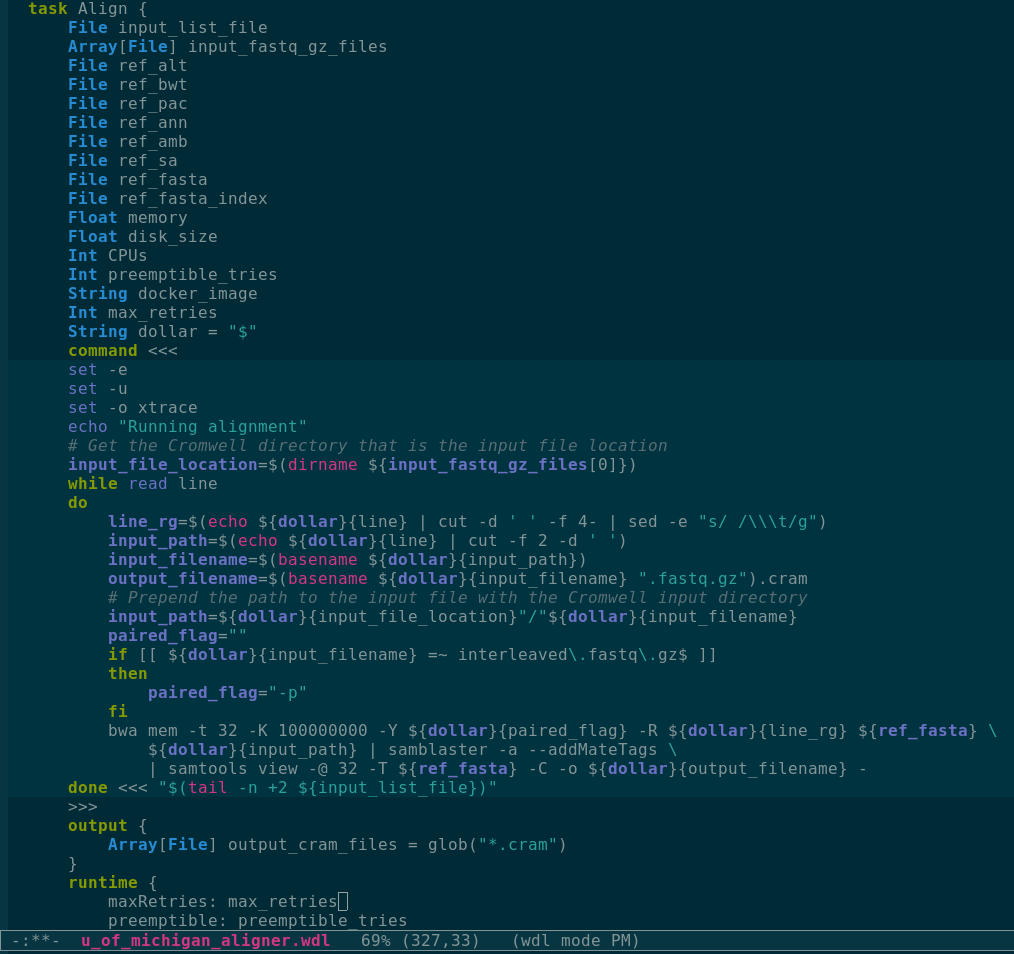Workflow Description Language (WDL) in Emacs
Jul 15 2019 emacs wdlI recently started working with WDL files. The Broad Institute recommends using Sublime and the syntax highlighter that they provide. They also provide a syntax highlighter for Vim. As Denis Loginov mentioned, they are working on an LSP implementation for WDL that could be used by tools to get syntax validation.
I looked first for a solution in Emacs, my go-to editor.
Luckily there was already a WDL mode available that I just slightly improved.
I also made a polymode to complement it and configured lsp-mode to use the WDL implementation.
All packages are available through MELPA as wdl-mode, poly-wdl, lsp-mode.
Other useful commands include (setq-default indent-tabs-mode nil) and the whitespace-mode to ensure consistent indents (see the WDL section of my Emacs page).
wdl-mode
The wdl-mode package provides syntax highlighting and indentation. It was developed by Xiaowei Zhan.
I noticed that the indentation was not triggered in the presence of space(s) after the character that should trigger it ({, <<<, }, >>>).
Maybe this space is not supposed to be there in the first place.
Still, some the files I was working with (or some of TOPMed’s workflows) had those sometimes.
I think it’s worth catching those, so I modified the package.
It’s now a PR in the main repo.
If it’s not merged and part of the next version on MELPA, it could always be modified locally (e.g. in the .emacs.d/elpa/wdl-mode*/wdl-mode.el).
poly-wdl
Starting from existing polymodes, I wrote one for WDL. The goal was to automatically switch to “shell mode” in the command chunks, mostly to get the appropriate indentation. The poly-wdl package is now in MELPA and I’m glad I got to contribute to MELPA even if just with a simple and field-specific package.
Language Server Protocol
There is an LSP implementation for WDL that can be used by Emacs to provide syntax validation and (some) auto-completion. It’s still under active development but it seems to work well already.
To use it in Emacs, the python package providing the server needs to be installed first and Emacs’ lsp-mode needs to be configured:
- Install the LSP server for WDL:
pip install wdl-lsp(orpip3). - Install packages through MELPA:
lsp-mode,lsp-uiandcompany-lsp. - Add to
.emacsfile:
(require 'lsp-mode)
(add-to-list 'lsp-language-id-configuration '(wdl-mode . "wdl"))
(defgroup lsp-wdl nil
"LSP support for WDL."
:group 'lsp-mode
:link '(url-link "https://github.com/broadinstitute/wdl-ide"))
(defcustom lsp-wdl-server-command "wdl-lsp"
"Command to start wdl-lsp."
:group 'lsp-wdl
:risky t
:type 'file)
(lsp-register-client
(make-lsp-client :new-connection (lsp-stdio-connection
(lambda () lsp-wdl-server-command))
:major-modes '(wdl-mode)
:priority -1
:server-id 'wdl))
(add-hook 'wdl-mode-hook #'lsp)
;; Syntax validation interface
(require 'lsp-ui)
(add-hook 'lsp-mode-hook 'lsp-ui-mode)
(setq lsp-ui-sideline-enable nil)
;; To get some auto-completion
(require 'company-lsp)
(push 'company-lsp company-backends)Note: The first time a file is opened, the package will ask what is the root of the project.
I use the folder that contains the WDL file because I don’t think project structures are integrated at this point.
This can be changed at any time using M-x lsp-workspace-folders-remove and M-x lsp-workspace-folders-add.
Screenshots
As an example, here is part of a TOPMed workflow for read alignment available here.
I removed empty lines and some comments to make it more compact.

Syntax validation (error message at the bottom)

Auto-completion
